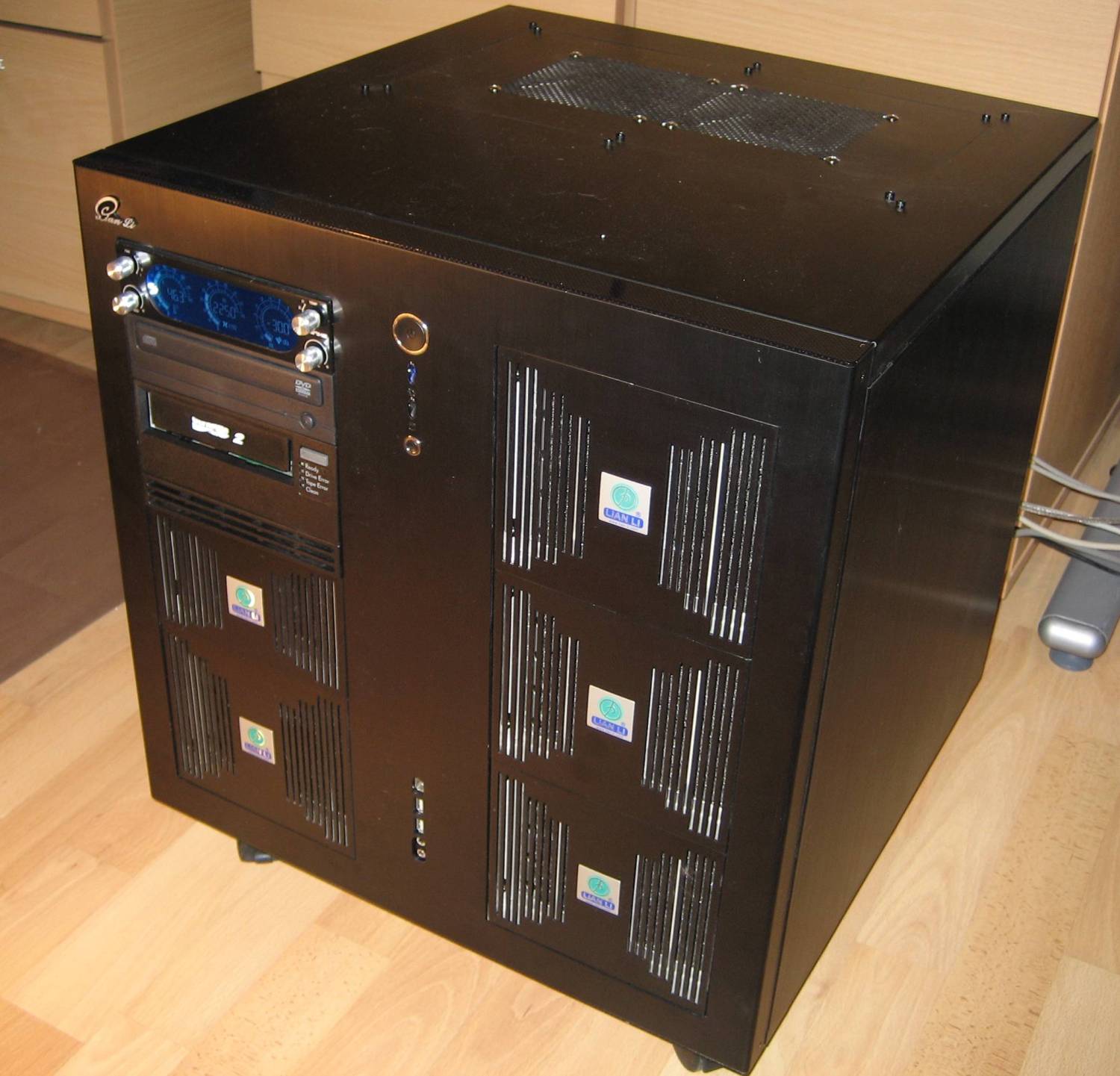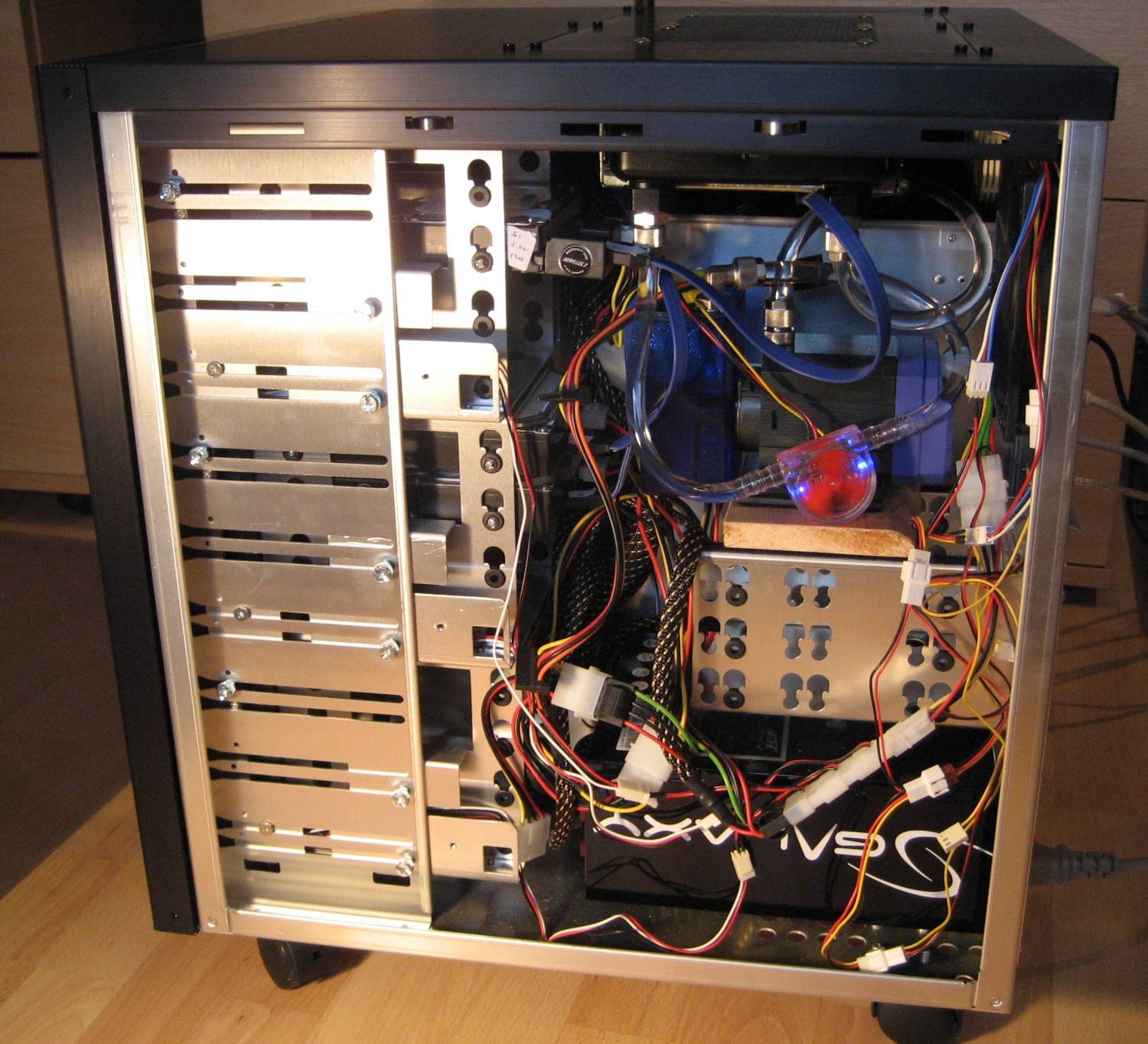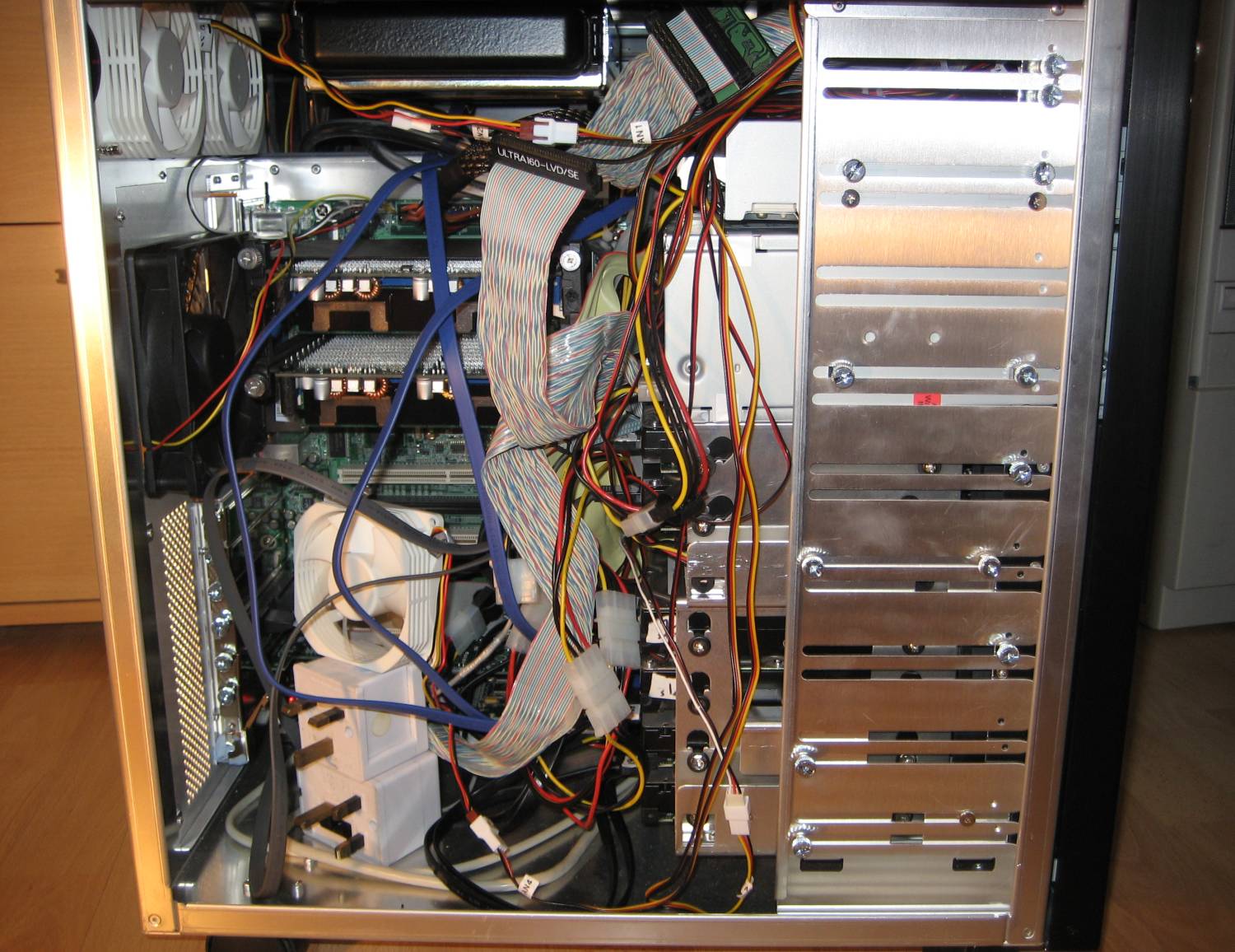New Monster Server...
The following are images of the new server that I've recently designed and built,
as so many people have been asking about it...
|
|
| Motherboard |
Tyan S5382W |
| CPUs |
Two Xeon X5355 (Clovertown) Quad
Core @ 2.66GHz |
| Memory |
Eight 2GB FB-DIMM (16GB fitted -
expandable to 64GB max.) |
| PSU |
Enermax Galaxy EGX1000 1000 Watts - able to
support 24x hard drives plus 2x quad processors plus graphics
card (if needed!) |
| HDD |
2x 160Gb WD Caviar SATA2 (mirrored)
bootable |
|
8x 1TB Hitachi SATA2 (RAID5 =
6.36TB!!) |
|
2x 400Gb (striped) fast
'read-only' drive |
| Chassis |
Lian Li PC343B fitted with 4x 4 HDD
carriers, |
| |
1x 3 HDD front carrier, 1x 3 HDD
rear carrier and top radiator panel. All aluminium. Firewire, 2x
USB2 and audio on front panel. 18 inch 'cube'. |
| Tape Drive |
Freecom 460i LTO2 Ultrium2 200/400GB
SCSI - this takes the virtual machines off to tape at 100GB/hour
with full verify (double if only use the read-after write verify
the drive offers) |
| Water Cooling |
Innovatek Dual Xeon Kit |
| DVD |
Samsung 16x DVD |
| SCSI |
HP U320 PCI-X/133 |
| RAID Controller |
Adaptec 2820SA 8-port SATA2 |
| Fan/Temp Controller |
Kama Meter (4 fans + 4 temps) |
| Graphics |
On-board ATI ES1000 chip - 32MB -
not really up to gaming - but there is a PCI Express x16 (but
only wired for x8) slot free that could take a proper card! |
|
|
|
|
|
|
|
|
| Concept! |
The reason for the design that
emerged was to allow multiple developers to run multiple virtual
workstations over Terminal Services. Hence the huge hard drive,
memory and CPU requirements. Each virtual machine is allocated
1GB of RAM, and uses about 15GB of hard drive and can use 2
cores (useful when running SQL Server within each virtual
machine!). Hence in the current configuration about a dozen
virtual PCs could be active simultaneously and not really impact
on performance. The idea was to provide a means to expand the hard
drive space beyond the initial specification. Hence in addition
to the 4x system/read-only drives fitted, the 8x 1TB drives fitted
as RAID5 provide 6500 gigabytes (6.3TB) of storage - enough for 400 virtual
PCs! And when that gets full there is room to add another 8 drives
of whatever the maximum capacity is at that time! |
|
|
|
|
|
 |
|
| The front of the chassis showing the hard
drive carriers (each with a fan) - total capacity is 20 hard drives.
Note dual 120mm radiator panel in the top plate. The Kama Meter (top left)
controls 4 fans and monitors 4 internal temperatures (the 4 chips of the
chipset). See also rear view - but machine has a total of 13 fans - but
as most are designed for quiet running (and some then undervoltaged
also) the noise is not significant. |
 |
| Right side of chassis houses the power supply
(bottom right). This was a bit long (only product on the market at the
time that suited) which restricted the lowest hard drive carrier to only
2 drives - so can fit 10 hard drives the front and also 3 more centre
right in the rear mounted carrier. Still waiting for the Hitachi 1TB
drives to fit (see later as now fitted!) - other smaller drives fitted at present to provide
temporary storage. This also provides the platform (sat atop a piece of
skirting board) for the water cooling pump/reservoir. Flow meter (red
fan in centre) connected to CPU fan header on the Motherboard so
shutdown occurs if the pump stops or water (distilled) leaks out! |
 |
| Left side houses the motherboard etc. Room
this side for 7 hard drives, plus the double height tape drive, the DVD
and the Kama Meter. As the box was really an ATX format and the
motherboard was eATX there was no air flow over chipset - so as Tyan had
made all 4 passively cooled an improvised cooling system of an internal
80mm fan was used (sat atop 2 mains adapters (bottom left) until I make
a better 'tower' for it to sit on!) This keeps the chipset running at
about 50 degrees C. The spaghetti wiring will get worse once the 8 1TB
drives are finally fitted! UPDATE: I added 40mm fans to each of the
chipset heatsinks - this dropped the temperatures from 50 to below 40
degrees C |
 |
| The motherboard was the only suitable unit
and is quite different to most. See top left area as this is where the 2 memory
riser cards are installed - each takes 8 memory chips - up to 4GB each -
giving a 64GB max memory capability (funds allowing!!) I've used 8x 2GB
units giving 16Gb to start with (as they are MUCH cheaper) - with plenty
of scope to expand if needed. The motherboard also contains 2 on-board
RAID controllers (sockets bottom right) - an 8 drive SAS/SATA2 unit plus
a 6 drive SATA2 unit. Note: anything to the right of the expansion slots
is not going to be easily accessible once installed - so get all the
SATA / IDE / floppy cables in before fitting all the drive carriers! |
 |
| Once the motherboard is fitted to the
chassis you can see the location of the 2 processors is going to be
behind the front drive bays, so could not use the stock heat sinks, so
had to go water-cooled instead. Only the bottom 2 expansion slots (both
PCI-X/133) are used (RAID card and SCSI card). There are also a pair of
PCI-X/100 slots, a pair of PCIe x16 slots (although wired for x8 and not
on the same controller so cannot do SLI graphics) plus a PCI slot also.
This also shows the dual memory riser cards - at present only 8 of the
16 slots are used - and see how the whole area is vented by the 120mm
rear fan. |
 |
| These are the water-cooling blocks, against
one of the 120mm fans used on the radiator top panel for size. These
needed about 45mm clearance from the pack panel, so the 60mm this
chassis provided was perfect. These keep the CPUs running at about 40
degrees C. |
 |
| UPDATE At last the 8 hard
drive RAID set is installed. These are the Hitachi 1TB (1000GB) units -
so in RAID-5 they give appear as a single hard of 6.36TB. It did take
the best part of a day to format the drive - but at least I'm safe
knowing (as I've tested it!!) that if a drive fails I can just swap in
the spare and rebuild it with NO downtime. YES - I tried it - I pulled
out one of the SATA cables - the alarm went off on the Adaptec
controller card - cancelled that - plugged the cable back in and it
rebuilt the array automatically. It even sent me emails to tell me what
it was doing... |